Frank Leslie’s Illustrated Newspaper, January 5, 1861
Fort Moultrie Evacuated—The Guns Spiked—The Gun-Carriages Burnt—Captain Foster left in Charge with a few Men—Colonel Anderson in Possession of Fort Sumpter.
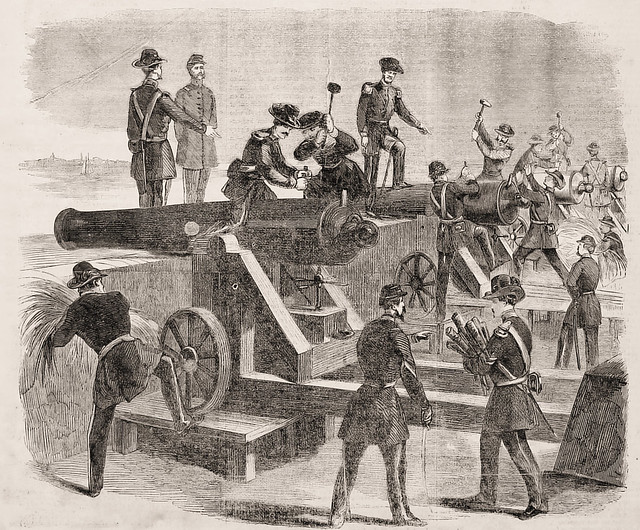
Spiking the Guns in Fort Moultrie, Charleston, S. C., Previous to the Evacuation of the Fort by Col. Anderson and the U. S. Troops
On Thursday, at noon, New York was thrown into a state of terrible excitement by rumors which grew and grew, that Fort Moultrie had been attacked by the citizens of Charleston, taken and burnt. Expressions of regret predominated greatly, as it was feared that compromise would now be entirely out of the question. By degrees, as the telegraphic dispatches arrived slowly and meagrely, the excitement subsided in a measure, but expectation was feverish as to what the morrow would bring forth.
Up to the time of our going to press the only facts positively known were, that on Christmas night Colonel Anderson evacuated Fort Moultrie and took possession of the almost impregnable Fort Sumpter, which, though not fully armed, is still armed sufficiently for all purposes of defence. Before abandoning Fort Moultrie, the commander had all the guns spiked, rendering them of no practical use to any who may. come after him. The gun
carriages, of which there were a vast number, were ordered to be burnt, the fire and smoke from which doubtless gave rise to the report that the fort had been.destroyed. It is positively asserted that in abandoning Fort Moultrie and taking possession of Fort Sumpter, Colonel Anderson acted upon his own responsibility. Whatever his reasons were, he doubtlessly deemed them sufficiently grave to warrant his acting without orders, but he will assuredly have to render a strict account for this bold and important strategical movement.
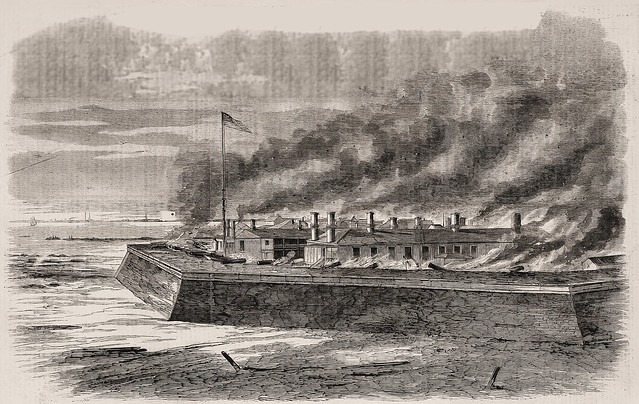
Evacuation of Fort Moultrie, and Burning of the Gun Carriages, On Sullivan’s Island, Charleston Harbor, S. C.
It is said that the authorities of Charleston have taken possession of the telegraph and assumed its entire control, therefore we remain in anxious uncertainty as to what action was taken after the abandonment of the fort, the burning of the gun carriages and the defiant seizure of Fort Sumpter, at the moment, too, when the South Carolina Commissioners were on the way to Washington, authorized to settle all matters of dispute.
We give in this number accurate pictures of the interior and exterior of Fort Moultrie, together with the exciting scenes which have transpired there. The following description of the two Forts, Moultrie and Sumpter, with the map which we engrave, will show their relative strength and position:
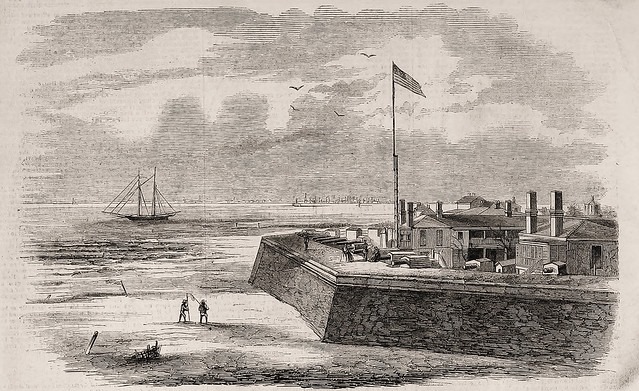
Exterior View of Fort Moultrie, On Sullivan’s Island, in the Harbor of Charleston, S.C.
as it Appeared Previous to the Evacuation. – from a Photograph by _ Luce, Esq.
Fort Moultrie.
This fortification is an enclosed water battery, having a front on the south or water side of about three hundred feet, and a depth of about two hundred and forty feet. It is built with salient and re-entering angles on all sides, but until the works now going on there were undertaken the south wall could have been easily scaled, owing to the accumulation of sand from the beach. Some improvement, however, has been recently effected in this respect. The outer and inner wall are of brick; capped with stone, and filled in with earth, making a solid wall fifteen or sixteen feet in thickness. The work now in progress consists in cleaning the sand from the walls of the fort, ditching it around the entire circumference, and erecting a glacis, closing up the postern gates in the east and west walls, and instead, cutting sally ports, which lead into strong outworks on the south-east and south-west angles, in which twelve pounder howitzer guns will be placed, enabling the garrison to sweep the ditch on three sides with grape and canister. The north-west angle of the fort has also been strengthened by a bastionette, to sustain the weight of a heavy gun which will command the main street of the island. The main entrance has also been better secured, and a trap door two feet square cut in the door for ingress and egress. At this time the height of the wall, from the bottom of the ditch to the top of the parapet, is twenty feet. The ditch is from twelve to fifteen feet wide at the base, and fifteen feet deep. The nature of the soil would not soon to admit of this depth being increased, quicksand having been reached in many places. The work on the south side is nearly finished. The counterscarp is substantially built of plank, and spread with turf. The glacis is also finished. It is composed of sand, and covered with layers of loam and turf, all of which is kept firmly in place by the addition of sections of plank nailed to uprights sunk in the sand, and crossing each other at right angles—making squares of about ten feet each. The purpose of the glacis, which is an inclined plane, is to expose an attacking party to the fire of the guns, which are so placed as to sweep it from the crest of the counterscarp to the edge of the beach.
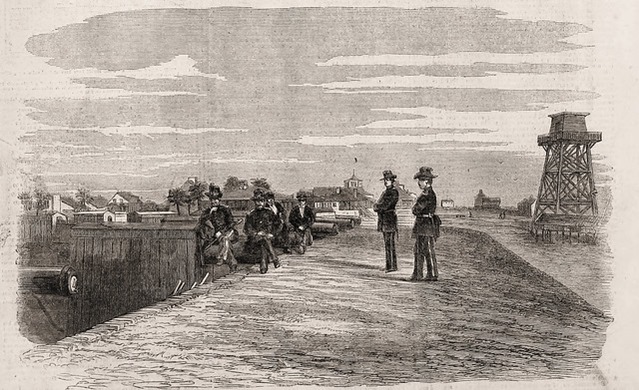
View of the Ramparts of Fort Moultrie, Charleston Harbor, S. C. – from a Photograph by _ Luce, Esq.
Fort Sumpter
Fort Sumpter is one of the most powerful military works in the United States. It is built on an artificial island, immediately within the mouth of Charleston bay, between Fort Moultrie- and the site of old Fort Johnson, of Revolutionary memory, and equidistant from those points about three-fourths of one mile. The ship channel leading from the sea to the City of Charleston is between Forts Sumpter and Moultrie, and is entirely commanded within half range by them. Between Forts Sumpter and Johnson the water is very shallow, only available for vessels of very light draft, and then only at high water. The artificial island on which Fort Sumpter is built is constructed of the refuse from the granite quarries of New England. Ten years were consumed in its completion, at a cost of half a million of dollars. The fortification is of a pentagonal form, built of solid brick masonry. The walls are fifty feet in height, and from eight to ten feet in thickness, and are pierced for three tiers of guns, besides having necessary loopholes for musketry, and designed for an armament of one hundred and forty pieces of ordnance of all calibres. Two tiers of the guns are under bomb-proof casements, and the third or upper tier open, Or, in military parlance, en barbette—the lower tier for forty-two pounder Paixhan guns; the second tier for eight and ten-inch Columbiads, for .throwing solid or hollow shot, and the upper tier for mortars and twenty-four pound guns.
A brief account of the man who is now exciting so wide a discussion will interest our readers:
Major Robert Anderson, U.S.A., the commander of Fort Moultrie, was born in September, 1810, and graduated with high honor at West Point, July 1, 1825, the date of his commission as second lieutenant in the Third Regiment. He served in the Black Hawk War, and in 1838 was assistant instructor and inspector at West Point. In 1838 he became aide-de-camp to Major-General Scott; and in the following year published “Instruction for Field Artillery, Horse and Foot, arranged for the service of the United States.” “For gallantry and successful conduct in the war against the Florida Indians,” he received the brevet of captain, bearing date April 2, 1838. July 7, 1838, he became assistant adjutant-general with the rank of captain, which he relinquished subsequently to being promoted to a captaincy in his regiment, October 1841. In March 1848, he was with the Third Regiment of Artillery in the army of General Scott, and took part in the siege of Vera Cruz—being one of the officers to whom was entrusted, by General Bankhead, the command of the batteries. This duty he performed with signal skill and gallantry, and he continued with the army until its triumphal entry into the city of Mexico, in September following. During the operations in the valley of Mexico he was attached to the brigade of General Garland, which formed a part of General Worth’s division. In the attack on El Molino del Rey, on the 8th of September, where he was wounded very severely, his conduct was the theme of especial praise, and for gallant and meritorious conduct in this battle he was promoted to the brevet rank of major, dating September 8, 1847. October 5, 1857, he was promoted to the position of Major of the First Artillery, which he now holds. He is a man of “clear grit pluck” and high-toned honor, and a devoted lover of the Union.
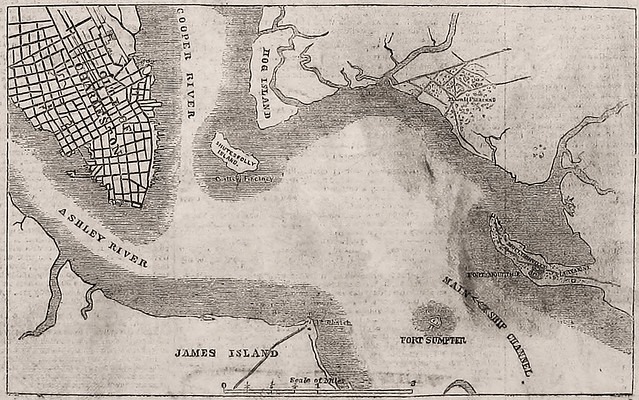
Plan of the Harbor of Charleston, S. C., Showing the Relative Position of the Several Fortresses
Postscript.
The last news from Charleston states that Forts Moultrie and Pinckney were taken possession of by the South Carolina military, and that the Palmetto flag was flying over those forts. as well as the Custom House and Post Office. It was also said that the South Carolina Commissioners at Washington had demanded from the President the immediate surrender of Fort Sumpter, or this shall be their last interview, and they will return to South Carolina and prepare for the worst.